superdrug b hyaluronic acid reviews
HOW TO USE: Spritz onto freshly cleansed skin, over makeup or whenever your skin needs a refreshing boost. Hold bottle at arm’s length and lightly mist over the face. For best results, use in combination with your favourite B. Day or B. Night cream.
SUPERDRUG B. HYDRATED HYALURONIC ACID FACIAL SPRITZ REVIEW
Welcome back to my blog Loves. Facial sprays are the raves of the moment with different brands out with theirs. Although, B. has had theirs for years now, I just got to try it out and I’m gonna be reviewing it today; the SUPERDRUG B. HYDRATED HYALURONIC ACID FACIAL SPRITZ.
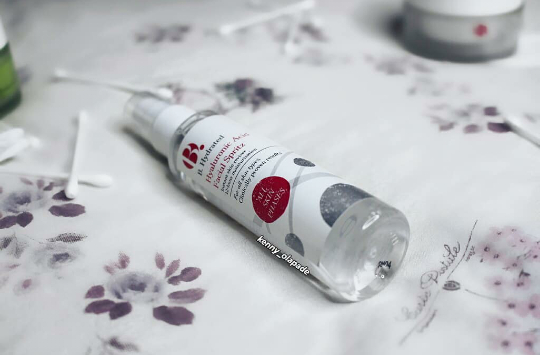
B. Hyaluronic Acid Facial Spritz Review
If you enjoy this post, please don’t forget to LIKE, SHARE, SUBSCRIBE to my blog and leave me nice COMMENTS.
CLAIM: Use B. Confident Hyaluronic Acid Facial Spritz to rapidly replenish the skin and lock in moisture for 12 hours without clogging pores. A skincare essential, ideal for use while traveling or to refresh makeup and hydrate tired skin for a smoother look.
Benefits
- 12hr hydration – Packed with Hyaluronic Acid to moisturise deep down.
- Boost skin’s radiance – Promotes a more healthy glow with regular use.
- Soothes and relaxes – Perfect pick me up for tired, fatigued skin.
INGREDIENTS: Aqua, Betaine, Propanediol, Polysorbate 20, Hamamelis Virginiana (Witch Hazel) Bark/Leaf/Twig Extract, Phenoxyethanol, Glycerin, Pentylene Glycol, Fructose, Urea, Caprylhydroxamic Acid, Alcohol Denat., Citric Acid, Methylpropanediol, Sodium Hydroxide, Disodium EDTA, Parfum, Allantoin, Maltose, Sodium Chloride, Sodium Lactate, Sodium PCA, Trehalose, Glucose, Sodium Hyaluronate (Hyaluronic Acid), Limonene, Linalool, Butylphenyl Methylpropional
HOW TO USE: Spritz onto freshly cleansed skin, over makeup or whenever your skin needs a refreshing boost. Hold bottle at arm’s length and lightly mist over the face. For best results, use in combination with your favourite B. Day or B. Night cream.
PRICE: £7.99 at Superdrug. It’s usually on sale for half price or BOGO.
REVIEW
- Packaging:It is packed in a clear plastic cylindrical bottle with a white spritz applicator. It’s a good packaging with good grasp and the spritz deliver a good amount of fine mist of fluid
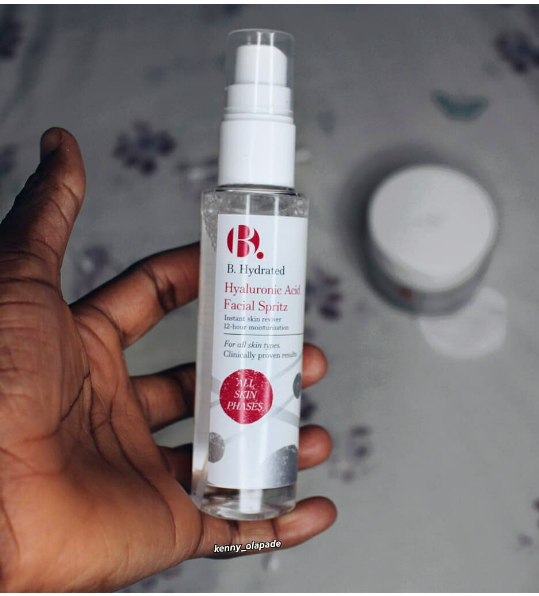
B. Hyaluronic Acid Facial Spritz Review
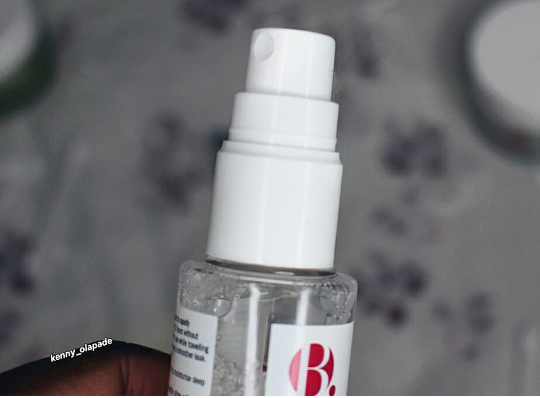
B. Hyaluronic Acid Facial Spritz Review
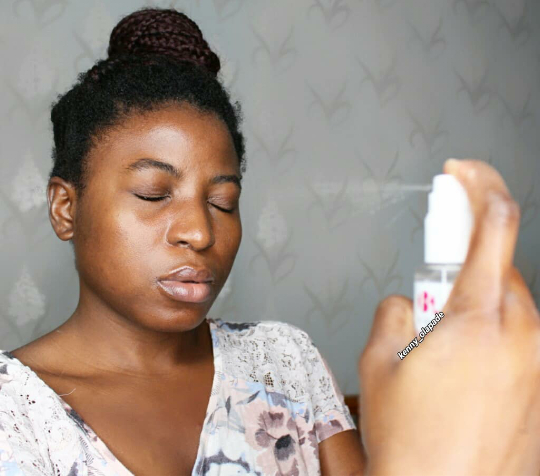
B. Hyaluronic Acid Facial Spritz Review
- Colour and Consistency: It’s clear and liquidy similar to water
- Scent: It smells like most products in the B. range; fresh and fruity.
On Application
- I apply it on my face after cleansing and at times after makeup.
- It delivers a good amount of fine mists,
- I let it dry down then moisturise my face.
- It feels so cool and moist on the face
- You can feel that instant hydration on the face
- It’s very moisturising and feels so good on the skin.
- It doesn’t make my face you look oily or greasy and it doesn’t smudge makeup.
- It’s come in useful, especially with this cold weather that has been torturing my skin.
- It provides instant moisture boost to the skin.
VERDICT: I give it 5/5. This is a product I never thought I needed. It’s so good and I love everything about it; its packaging, scent and how moisturising, cooling and refreshing it feels.

B. Hyaluronic Acid Facial Spritz Review
I hope you enjoy my review of this product. Do you use this product? Do you love it as well? COMMENT below, LIKE, and SHARE my post. Follow my blog via BLOGLOVIN or subscribe via E-MAIL and check out my Youtube Channel.
I’m a UK based beauty and lifestyle blogger sharing reviews on beauty products, beauty boxes and a whole lot more!
B Essence Facial Lotion
B is Superdrug’s own beauty brand which offers makeup, skincare and tanning products. The name is always a little annoying as a blogger as it’s technically B. however you can’t put full stops in product names or URLs when writing posts, but it’s B by Superdrug.
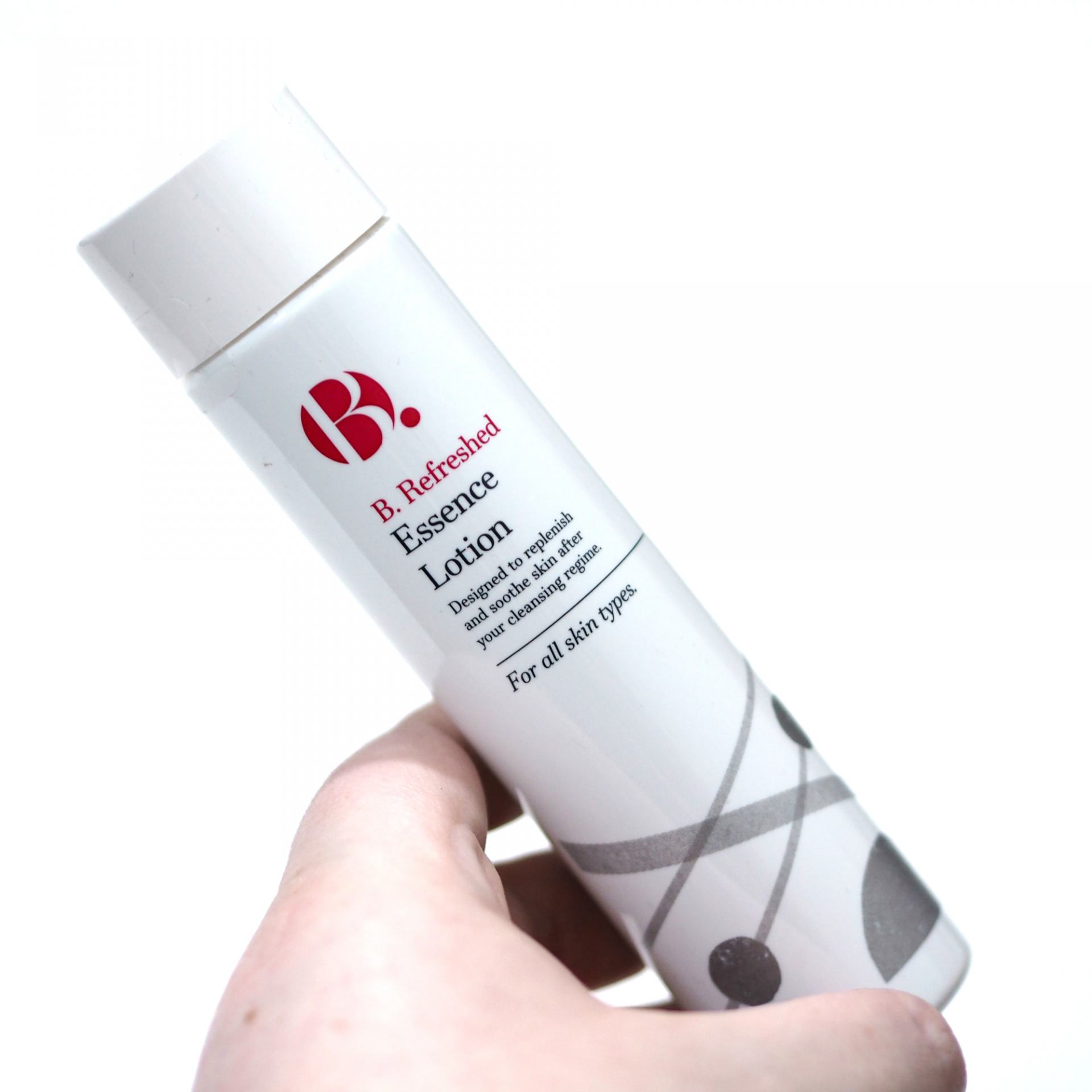
“B. Refreshed is a lightweight, soothing essence lotion. It replenishes skin with 12 hour intense moisture. Instantly soothes – Allantoin helps to soften, protect and soothe. Softens and smoothes – With naturally derived Algae Extract. 12hr hydration – Packed with Hyaluronic Acid to moisturise deep down. Dermatologically approved.“

The directions for the B Essence Facial Lotion are simple, you just apply a few drops into your hand and gently pat onto the skin until fully absorbed. For best results, Superdrug recommend using the essence both morning and night before your day/night cream.
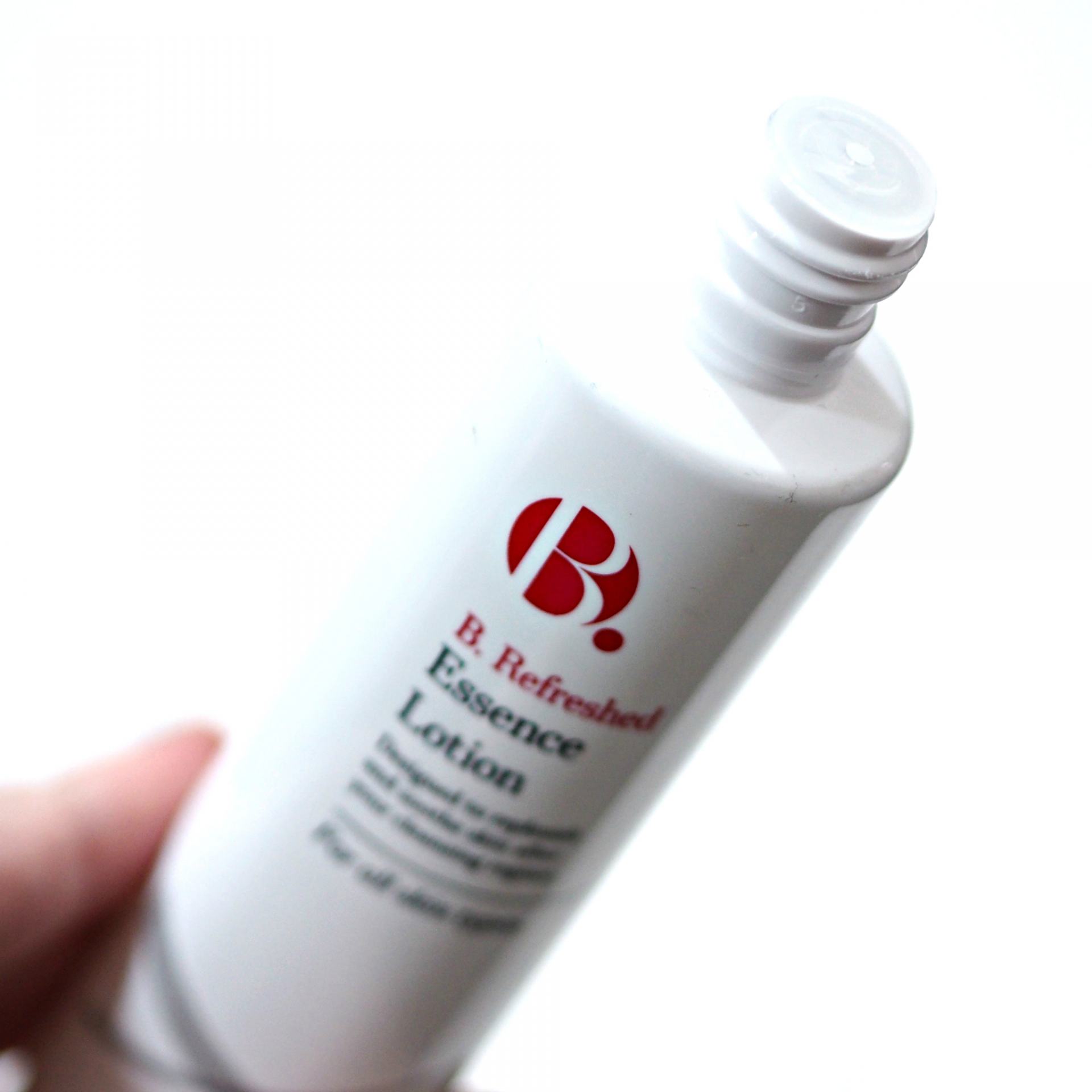
An essence is essentially a liquid which you apply to the skin with your hands rather than with a cotton pad, and can help to add in an extra layer of hydration for dehydrated skins and the B Essence Facial Lotion is such a lovely budget friendly essence.
It feels so soothing and pleasant to pat into the skin, and instantly leaves my skin feeling more hydrated and works well when applied to the skin before my serum as an extra layer of hydration. On my no makeup days, I also sometimes like to apply essence during the day, as I love how softening and hydrating they are.
They leave the skin feeling so fresh and soothed, and considering the B Essence Facial Lotion is pretty much always on a buy one, get one free deal and is only £6.99, it’s amazing.
You can purchase the B Essence Facial Lotion right here.
All products featured on Gemma Etc. are PR samples or gifted items, unless otherwise indicated. This post may contain affiliate links. If you wish to find out more, please see my Disclaimer within my navigation bar.

About Gemma
I’m a UK based beauty and lifestyle blogger sharing reviews on beauty products, beauty boxes and a whole lot more!
Related Posts
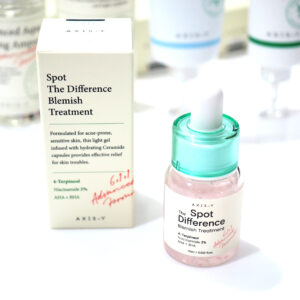
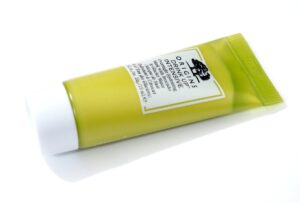

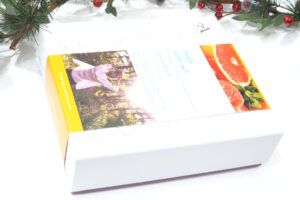
Hey, there!
I also liked how my skin felt using the Multi-protecting Serum. And the 3 In One Moisture Balm, Primer and mask I found was very good used as a mask to give my skin a needed glow.
Optimum Swiss Ice Wine Face and Neck Cream
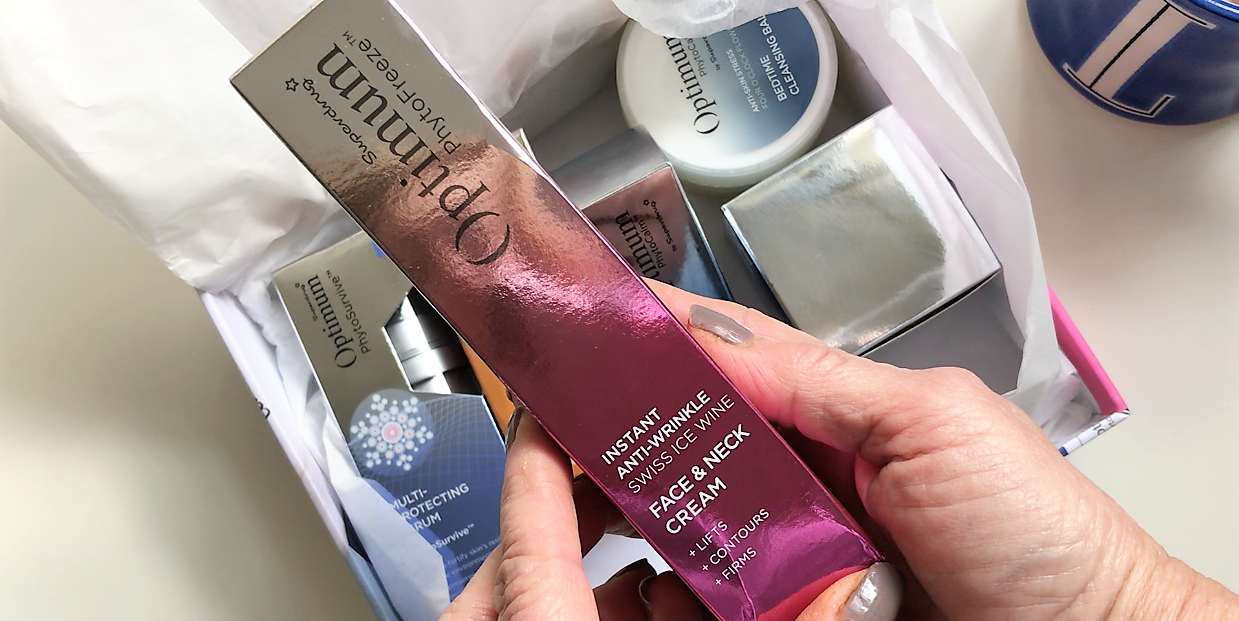
PhytoFreeze
contains a unique active ingredient Vin-upLift based on premium Swiss Ice Wine produced from naturally frozen ripe grapes. This face and neck cream ( I’ve only used this on my neck so that I could try the other creams) worked quite well. I didn’t notice a huge difference but definitely some difference. Maybe over time, I would see more of a difference.
Acetyl Dipetide
Helps stimulate elastin synthesis to fight against skin sagging and improve skins resistance to gravity. The face and neck cream also contains Shea Butter and Pro-vitamin B5
I need all the help my neck can get! I rarely used creams on my neck until my forties and I’m definitely paying the price for that now. This cream has a barely-there floral scent to it. I found that the cream sunk straight into my skin on my neck rapidly. I always find that a good sign, and I do like it.
It's quite a multi-tasker: can be used to improve skin moisturization, as a solvent, to boost preservative efficacy or to influence the sensory properties of the end formula.
Superdrug b hyaluronic acid reviews
Good old water, aka H2O. The most common skincare ingredient of all. You can usually find it right in the very first spot of the ingredient list, meaning it’s the biggest thing out of all the stuff that makes up the product.
It’s mainly a solvent for ingredients that do not like to dissolve in oils but rather in water.
Expand to read more
Once inside the skin, it hydrates, but not from the outside – putting pure water on the skin (hello long baths!) is drying.
One more thing: the water used in cosmetics is purified and deionized (it means that almost all of the mineral ions inside it is removed). Like this, the products can stay more stable over time.
Propanediol is a natural alternative for the often used and often bad-mouthed propylene glycol. It's produced sustainably from corn sugar and it's Ecocert approved.
It's quite a multi-tasker: can be used to improve skin moisturization, as a solvent, to boost preservative efficacy or to influence the sensory properties of the end formula.
A super commonly used 5 unit long, cyclic structured silicone that is water-thin and does not stay on the skin but evaporates from it (called volatile silicone). Similar to other silicones, it gives skin and hair a silky, smooth feel.
It's often combined with the non-volatile (i.e. stays on the skin) dimethicone as the two together form a water-resistant, breathable protective barrier on the skin without a negative tacky feel.
- It's a super common and super debated skincare ingredient
- It has several benefits: great solvent, penetration enhancer, creates cosmetically elegant, light formulas, great astringent and antimicrobial
- It can be very drying if it's in the first few ingredients on an ingredient list
- Some experts even think that regular exposure to alcohol damages skin barrier and causes inflammation though it's a debated opinion (read more in geeky details tab)
A light, velvety, unique skin feel liquid that is a good solvent and also makes the skin feel nice and smooth (aka emollient). It's often used in makeup products mixed with silicones to give shine and slip to the product. It's also great for cleansing dirt and oil from the skin as well as for taking off make-up.
- A natural moisturizer that’s also in our skin
- A super common, safe, effective and cheap molecule used for more than 50 years
- Not only a simple moisturizer but knows much more: keeps the skin lipids between our skin cells in a healthy (liquid crystal) state, protects against irritation, helps to restore barrier
- Effective from as low as 3% with even more benefits at higher concentrations up to 20-40% (around 10% is a good usability-effectiveness sweet spot)
- High-glycerin moisturizers are awesome for treating severely dry skin
The emollient plant oil coming from the seeds of the white flowering plant called meadowfoam. Meadowfoam Oil has a unique fatty acid composition with 95% of it being long chain fatty acids (eicosenoic acid C20:1 – 61%, docosenoic acid C22:1 – 16% and docosadienoic acid C22:2 – 18%) that make the oil extraordinarily stable. It also contains antioxidant components such as vitamin E as well as phytosterols.
Apart from Meadowfoam Oil's crazy stability, the oil is described as non-greasy, rapidly absorbed and having a similar skin feel to more often used jojoba oil. The oil is ideal for products where a soft, smooth, silky feel is required whether it be on skin or hair.
A light-feeling, volatile (meaning it does not absorb into the skin but evaporates from it) silicone that gives skin a unique, silky and non-greasy feel. It has excellent spreading properties and leaves no oily residue or build-up.
A kind of polymer (big molecule from repeated subunits) that helps to create beautiful gel-like textures. It's also a texturizer and thickener for oil-in-water emulsions. It gives products a good skin feel and does not make the formula tacky or sticky.
It works over a wide pH range and is used between 0.5-1.2%.
We don’t have description for this ingredient yet.
- A multi-functional skincare superstar with several proven benefits for the skin
- Great anti-aging, wrinkle smoothing ingredient used at 4-5% concentration
- Fades brown spots alone or in combination with amino sugar, acetyl glucosamine
- Increases ceramide synthesis that results in a stronger, healthier skin barrier and better skin hydration
- Can help to improve several skin conditions including acne, rosacea, and atopic dermatitis
It’s pretty much the current IT-preservative. It’s safe and gentle, but even more importantly, it’s not a feared-by-everyone-mostly-without-scientific-reason paraben.
It’s not something new: it was introduced around 1950 and today it can be used up to 1% worldwide. It can be found in nature – in green tea – but the version used in cosmetics is synthetic.
Expand to read more
Other than having a good safety profile and being quite gentle to the skin it has some other advantages too. It can be used in many types of formulations as it has great thermal stability (can be heated up to 85°C) and works on a wide range of pH levels (ph 3-10).
It’s often used together with ethylhexylglycerin as it nicely improves the preservative activity of phenoxyethanol.
We don’t have description for this ingredient yet.
We don’t have description for this ingredient yet.
We don’t have description for this ingredient yet.
The plant extract coming from the leaves of English plantain or narrowleaf plantain that's native to Europe and Asia. The plant has plenty of traditional medicinal uses. Regarding the leaf and the skin, it's used to promote maturation of abscess and to speed up the recovery of incisions, pimples or wounds.
Modern studies do confirm that the plant, and specifically the leaves are loaded with active compounds that give the extract anti-inflammatory, antibacterial, and antioxidant magic properties. An in-vitro (made on chicken membrane, not on real people) study in Phytotherapy Research found that Plantain Leaf Extract in large concentrations has a comparable soothing effect to anti-inflammatory big shot, hydrocortisone.
Expand to read more
Another study in the Journal of Herbal Medicine examined the antioxidant properties of the plant and found that the leaf extract has potent antioxidant activity (thanks to its flavonoids and hydroxycinnamic acids content) that's comparable or superior to multiple herbs and Chinese medicinal plants.
All in all, definitely a goodie plant extract that's good to spot on the ingredient list.
A high-molecular-weight silicone elastomer (rubber-like elastic material) that is usually blended with a base silicone fluid (such as dimethicone or cyclopentasiloxane) to give the formula a silky smooth feel and to act as a thickening agent.
It's a type of glycol that – according to the manufacturer – is an extremely good replacement for other glycols like propylene or butylene glycol. Its main job is to be a solvent, but it has also very good antimicrobial properties and acts as a true preservative booster. Also helps with skin hydration without stickiness or tacky feel.
The oil coming from the plant Linum Usitatissimum or commonly called Flax. If you are into healthy eating, you probably know flaxseeds as a rich source of hard-to-eat-enough omega-3 fatty acids, or if you are into fashion, you probably have some light summer cloth made from linen.
As for skincare, flaxseed oil is one of the few natural plant oils that is a rich source (35-65%) of moisturizing and probably anti-inflammatory ω-3 fatty acid, aka linolenic acid. It also contains skin-nourishing oleic acid (11-35%) and barrier repairing linoleic acid (11-24%).
Expand to read more
According to manufacturer claims, it is used as an emollient, anti-inflammatory and healing agent and it is well-known to create smooth and soft skin.
Exactly what it sounds: nice smelling stuff put into cosmetic products so that the end product also smells nice. Fragrance in the US and parfum in the EU is a generic term on the ingredient list that is made up of 30 to 50 chemicals on average (but it can have as much as 200 components!).
If you are someone who likes to know what you put on your face then fragrance is not your best friend – there's no way to know what’s really in it.
Expand to read more
Also, if your skin is sensitive, fragrance is again not your best friend. It’s the number one cause of contact allergy to cosmetics. It’s definitely a smart thing to avoid with sensitive skin (and fragrance of any type – natural is just as allergic as synthetic, if not worse!).
A chelating agent that helps to preserve cosmetic products by neutralizing the metal ions (especially iron) in the formula (that usually get into there from water). Its special thing is that it also acts as a biostatic and fungistatic agent and remains active even at high pH.
It is often coupled with antimicrobial glycols (such as propanediol) to create a "preservative free preservative system" for cosmetic products.
We don’t have description for this ingredient yet.
Super common little helper ingredient that helps products to remain nice and stable for a longer time. It does so by neutralizing the metal ions in the formula (that usually get into there from water) that would otherwise cause some not so nice changes.
It is typically used in tiny amounts, around 0.1% or less.
It’s the – sodium form – cousin of the famous NMF, hyaluronic acid (HA). If HA does not tell you anything we have a super detailed, geeky explanation about it here. The TL; DR version of HA is that it's a huge polymer (big molecule from repeated subunits) found in the skin that acts as a sponge helping the skin to hold onto water, being plump and elastic. HA is famous for its crazy water holding capacity as it can bind up to 1000 times its own weight in water.
As far as skincare goes, sodium hyaluronate and hyaluronic acid are pretty much the same and the two names are used interchangeably. As cosmetic chemist kindofstephen writes on reddit "sodium hyaluronate disassociates into hyaluronic acid molecule and a sodium atom in solution".
Expand to read more
In spite of this, if you search for "hyaluronic acid vs sodium hyaluronate" you will find on multiple places that sodium hyaluronate is smaller and can penetrate the skin better. Chemically, this is definitely not true, as the two forms are almost the same, both are polymers and the subunits can be repeated in both forms as much as you like. (We also checked Prospector for sodium hyaluronate versions actually used in cosmetic products and found that the most common molecular weight was 1.5-1.8 million Da that absolutely counts as high molecular weight).
What seems to be a true difference, though, is that the salt form is more stable, easier to formulate and cheaper so it pops up more often on the ingredient lists.
If you wanna become a real HA-and-the-skin expert you can read way more about the topic at hyaluronic acid (including penetration-questions, differences between high and low molecular weight versions and a bunch of references to scientific literature).
It's a little helper ingredient that helps to set the pH of the products to be right. It has an alkaline pH and can neutralize acidic ingredients.
Biosaccharide Gum-1 is a pretty interesting kind of sugar ingredient that is created from sorbitol via bacterial fermentation.
According to the manufacturer it’s a “S.M.A.R.T.” sugar: it has Soothing, Moisturizing, Anti-aging, Restructuring and Touch properties. Let’s look at them quickly one by one.
Expand to read more
Soothing: the manufacturer tested out the soothing effect in vivo (meaning on humans that is always a good thing!) by measuring how 3% Biosaccharide Gum-1 decreased the tingling sensation caused by 10% lactic acid. The result was good: the tingling was decreased by 47%.
Moisturizing: Compared to famous hyaluronic acid, it turns out that the two are great together. HA has a quicker effect and provides more instant hydration (much more hydration was measured after 1h of application), while our nice sugar has a somewhat delayed effect demonstrating stronger hydration after 3h of application. After 8 hours both had similar moisturizing effect.
Anti-aging: According to ex-vivo tests (meaning not on humans, so do not trust it too much) Biosaccharide Gum-1 can stimulate a protein in our skin called sirtuin-1. This is supposed to help our skin cells to live longer, and function better.
Resurfacing: The sirtuin-1 stimulation also results in quicker cell renewal – something that happens anyway but slows down as we age. And the quicker cell renewal is good because it helps the regeneration of the barrier function. That is especially nice for fragile, sensitive skin.
Touch: our fermented sugar is not only good to the skin, but it also feels great on the skin. It gives a nice “soft touch” feeling and makes the products pleasant to use.
The bottom line is that the above info is from the manufacturer (and we could not find any relevant independent research) so obviously take it with a grain of salt. But Biosaccharide Gum-1 does look as an interesting and promising ingredient that’s why it earned our goodie rating.
It goes by the trade name "Phytodermina Lifting" that refers to two things: it's a "lifting" ingredient and it comes from plant raw materials.
The manufacturer claims that it gives the skin a marked lifting effect, moisturizes, makes the skin soft and smooth, enhances brightness, and helps make-up to stay on after application.
It's one of the most commonly used thickeners and emulsion stabilizers. If the product is too runny, a little xanthan gum will make it more gel-like. Used alone, it can make the formula sticky and it is a good team player so it is usually combined with other thickeners and so-called rheology modifiers (helper ingredients that adjust the flow and thus the feel of the formula). The typical use level of Xantha Gum is below 1%, it is usually in the 0.1-0.5% range.
Btw, Xanthan gum is all natural, a chain of sugar molecules (polysaccharide) produced from individual sugar molecules (glucose and sucrose) via fermentation. It’s approved by Ecocert and also used in the food industry (E415).
A super common and cheap fragrance ingredient. It's in many plants, e.g. rosemary, eucalyptus, lavender, lemongrass, peppermint and it's the main component (about 50-90%) of the peel oil of citrus fruits.
It does smell nice but the problem is that it oxidizes on air exposure and the resulting stuff is not good for the skin. Oxidized limonene can cause allergic contact dermatitis and counts as a frequent skin sensitizer.
Expand to read more
Limonene's nr1 function is definitely being a fragrance component, but there are several studies showing that it's also a penetration enhancer, mainly for oil-loving components.
All in all, limonene has some pros and cons, but – especially if your skin is sensitive – the cons probably outweigh the pros.
Linalool is a super common fragrance ingredient. It’s kind of everywhere – both in plants and in cosmetic products. It’s part of 200 natural oils including lavender, ylang-ylang, bergamot, jasmine, geranium and it can be found in 90-95% of prestige perfumes on the market.
The problem with linalool is, that just like limonene it oxidises on air exposure and becomes allergenic. That’s why a product containing linalool that has been opened for several months is more likely to be allergenic than a fresh one.
Expand to read more
A study made in the UK with 483 people tested the allergic reaction to 3% oxidised linalool and 2.3% had positive test results.
A common fragrance ingredient that has a nice floral scent and also goes by the name Lilial. It is a known fragrance allergen and as of 1st of March 2022, it has been banned in the EU due to animal studies showing a possible link to infertility (in rats – so no need to panic even if you used a product before with Butylphenyl Methylpropional).
It’s a common fragrance ingredient that is one of the “EU 26 fragrances” that has to be labelled separately (and cannot be simply included in the term “fragrance/perfume” on the label) because of allergen potential. Best to avoid if your skin is sensitive.
A common fragrance ingredient that smells like jasmine. It is one of the “EU 26 fragrances” that has to be labelled separately because of allergen potential. Best to avoid if your skin is sensitive.
Geraniol is a common fragrance ingredient. It smells like rose and can be found in rose oil or in small quantities in geranium, lemon and many other essential oils.
Just like other similar fragrance ingredients (like linalool and limonene) geraniol also oxidises on air exposure and becomes allergenic. Best to avoid if you have sensitive skin.
Citronellol is a very common fragrance ingredient with a nice rose-like odor. In the UK, it’s actually the third most often listed perfume on the ingredient lists.
It can be naturally found in geranium oil (about 30%) or rose oil (about 25%).
Expand to read more
As with all fragrance ingredients, citronellol can also cause allergic contact dermatitis and should be avoided if you have perfume allergy. In a 2001 worldwide study with 178 people with known sensitization to fragrances citronellol tested positive in 5.6% of the cases.
There is no known anti-aging or positive skin benefits of the ingredient. It’s in our products to make it smell nice.
A common fragrance ingredient that has a sweet scent somewhere between lily and fruity melon. Can be found in essential oils, such as lavender oil, orange flower oil or ylang-ylang.
In cosmetics, it can be used up to 1%. It’s one of the “EU 26 fragrances” that has to be labelled separately (and cannot be simply included in the term “fragrance/perfume” on the label) because of allergen potential. Best to avoid if your skin is sensitive.
It’s a common fragrance ingredient that has a light floral smell. It’s one of the “EU 26 fragrances” that has to be labelled separately (and cannot be simply included in the term “fragrance/perfume” on the label) because of allergen potential. Best to avoid if your skin is sensitive.
It's a pretty new peptide trade-named MATRIXYL™ synthe’6. The manufacturer claims that it can boost the production of 6 major components of the skin matrix (collagen I, III, IV, fibronectin, hyaluronic acid and laminin 5) that result in more even skin and fewer wrinkles particularly on the forehead and crow's feet. Using 2% of the active for two months daily, women reported a decrease in wrinkles by 31% up to 100%.